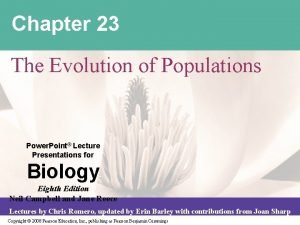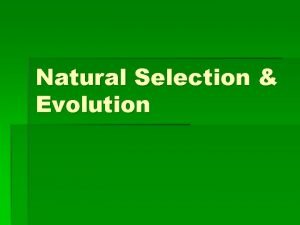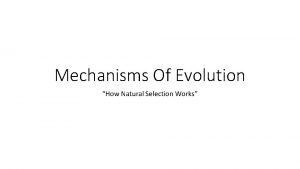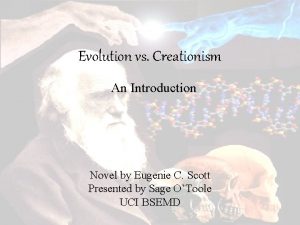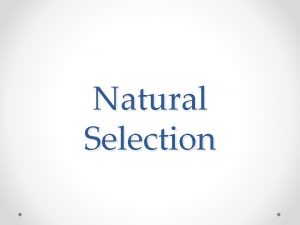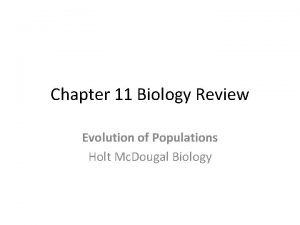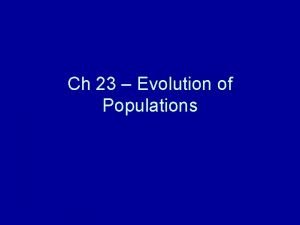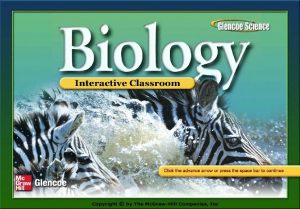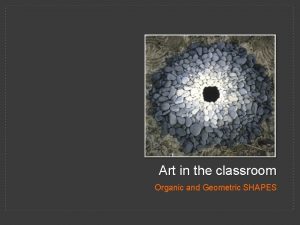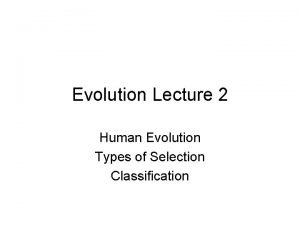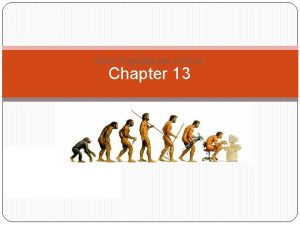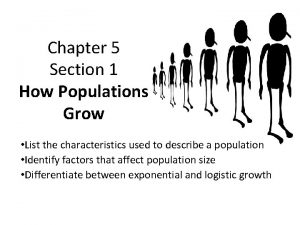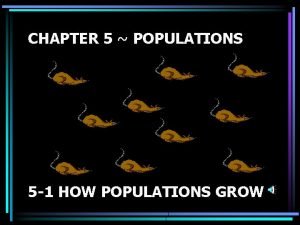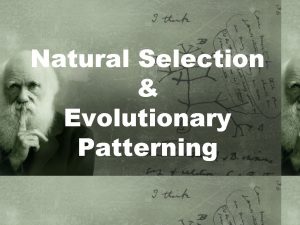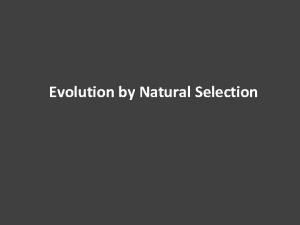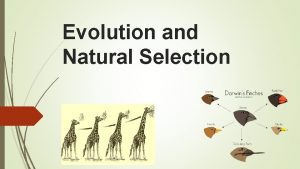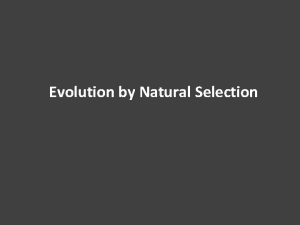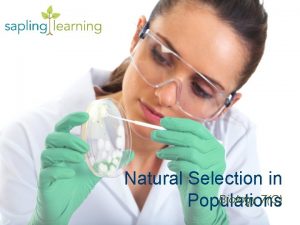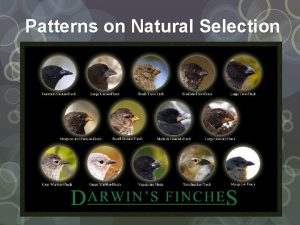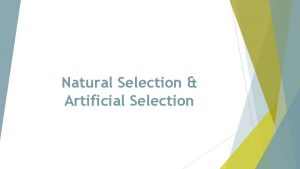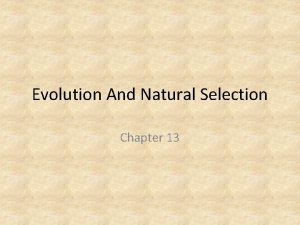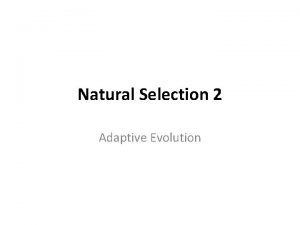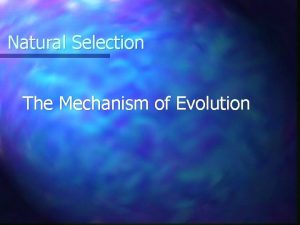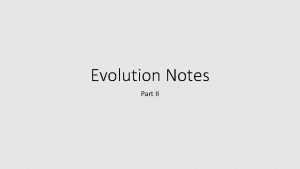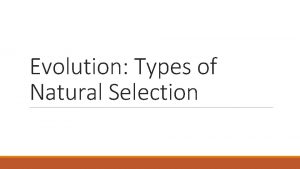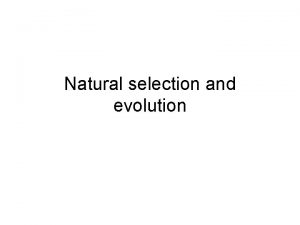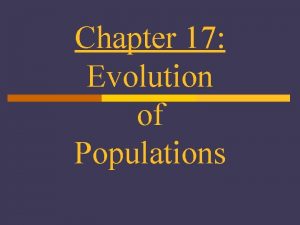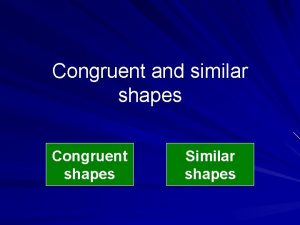Evolution How Natural Selection Shapes Populations Chapter 17























- Slides: 23

Evolution How Natural Selection Shapes Populations Chapter 17 Miller Levine Honors Biology NNHS 2015

Evolution & Natural Selection Work via Genetics & Heredity Genotype Phenotype Alleles Describe how natural selection affects genotypes by acting on phenotypes. (Hint- THINK BUNNIES!)

Definitions of Evolution Gradual process (over millions of years!) by which modern organisms have descended from ancient ancestors Evolution, in genetic terms, involves a change in the frequency of alleles in a population over time.

Sources of genetic variation Mutation – random changes in the DNA sequence Gen Shuffling- during sexual reproduction Creating haploid cells Crossing over

Natural selection acting on a single gene trait Can lead to changes in allele frequencies and, thus, to changes in phenotype frequencies Think of those Naked Bunnies!

Polygenic traits If a trait is influenced by more than one gene, it is referred to as a polygenic trait Polygenic traits often produce a normal distribution curve of distribution curve variation. In these cases, we refer to the phenotype as a .

Polygenetic Trait- distribution of phenotypes

Natural selection acting on a polygenic trait Natural selection can act on traits produced by multiple genes in Directional selection Stabilizing selection Disruptive selection


Directional Selection Changes the trait in one direction or the other – bigger or smaller, darker colored or lighter colored, faster or smaller, etc.

3 Ways Natural Selection Affects Genotypes 1. Directional Selection favors individuals at one end of the phenotypic range. Most common during times of environmental change or when moving to new habitats. Example: Greyhounds

3 Ways Natural Selection Affects Genotypes Disruptive Selection Favors extreme over intermediate phenotypes. Occurs when environmental change favors an extreme phenotype. If pressures are too strong and last long enough they can cause the curve to split.

3 Ways Natural Selection Affects Genotypes 3. Stabilizing Selection favors intermediate over extreme phenotypes. Reduces variation and maintains the current average. Example : Siberian Husky

Genetic Drift Natural selection is NOT the only source of evolutionary change. Smaller populations do not always follow laws of probability. Individuals may leave more descendants than other individuals by chance A number of chance occurrences can cause an allele to become common in a population.

Genetic drift Bottlenecks Founder effect

The Hardy-Weinberg Principle Genetic equilibrium – if a population is NOT experiencing natural selection the allele frequencies in a population will remain the same IF nothing is disturbing equilibrium then: p 2 + 2 pq +q 2 = 1. 0 5 conditions that can disturb genetic equilibrium: Nonrandom mating (sexual selection) Small population size (genetic drift) Immigration or emigration Mutations Natural selection

Applying Hardy-Weinberg to Alleles Example: In a certain breed of fish, blue is dominant to yellow Blue fish can have the following genotype(s): BB Bb Yellow fish can have the following genotype(s): bb Genetic Variables: p= the frequency of dominant allele B (blue) (frequency = total # of B alleles/total number of alleles) q= the frequency of recessive allele b (yellow) (frequency = total # of b alleles/total number of alleles) Since there are only two alleles in the population and everyone in the population has one of the two alleles, the frequencies of the two must add up to one. p+ q = 1 (remember 1 --> 100%)

Hardy-Weinberg Equation Heterozygous fish Ex: The equation: 1. 0 = p 2 + 2 pq + q 2 Where: p 2 = frequency of BB genotype 2 pq = frequency of Bb genotype q 2 = frequency of bb genotype B b BB Bb bb B p q p 2 pq q pq 2 q p

Let’s Watch a Video: http: //ed. ted. com/lessons/five-fingers-ofevolution The Five Causes of Evolution (take notes!) 1. Natural Selection 1. Small Populations or GENETIC DRIFT 1. Non-Random Mating 2. Mutation 3. Gene Flow (Immigration and Emmigration)

Break save for next time…

What is a species? A species is a population or group of populations that can interbreed and produce fertile offspring Speciation is the formation of a new species. Occurs thanks to Natural Selection Chance Events How does this happen?

Isolating Mechanisms The gene pool of two populations become separated. Reproductive Isolation When members of two species cannot Interbreed Produce fertile offspring These two populations will respond to natural selection and genetic drift as separate units

Types of Reproductive Isolation Behavioral isolation Geographic isolation Temporal isolation
 Chapter 16 evolution of populations vocabulary review
Chapter 16 evolution of populations vocabulary review Chapter 17 evolution of populations answer key
Chapter 17 evolution of populations answer key Chapter 23 the evolution of populations
Chapter 23 the evolution of populations Chapter 16 evolution of populations
Chapter 16 evolution of populations Chapter 23 the evolution of populations
Chapter 23 the evolution of populations Types of natural selection in evolution
Types of natural selection in evolution Natural selection vs evolution
Natural selection vs evolution Natural selection vs evolution
Natural selection vs evolution The slow gradual change in a species is called
The slow gradual change in a species is called Similarities
Similarities Natural selection vs artificial selection
Natural selection vs artificial selection Artificial selection vs natural selection
Artificial selection vs natural selection Stabilizing selection human birth weight
Stabilizing selection human birth weight Natural selection vs artificial selection
Natural selection vs artificial selection Stabilizing selection human birth weight
Stabilizing selection human birth weight Evolution of populations section 16-1 genes and variation
Evolution of populations section 16-1 genes and variation Evolution of populations section 11 review
Evolution of populations section 11 review Why are populations the smallest unit of evolution
Why are populations the smallest unit of evolution Chapter 15 section 1 darwins theory of natural selection
Chapter 15 section 1 darwins theory of natural selection Organic and geometric shapes
Organic and geometric shapes Evolution types
Evolution types Chapter 13 how populations evolve test
Chapter 13 how populations evolve test 5-1 how populations grow
5-1 how populations grow 5-1 how populations grow
5-1 how populations grow




